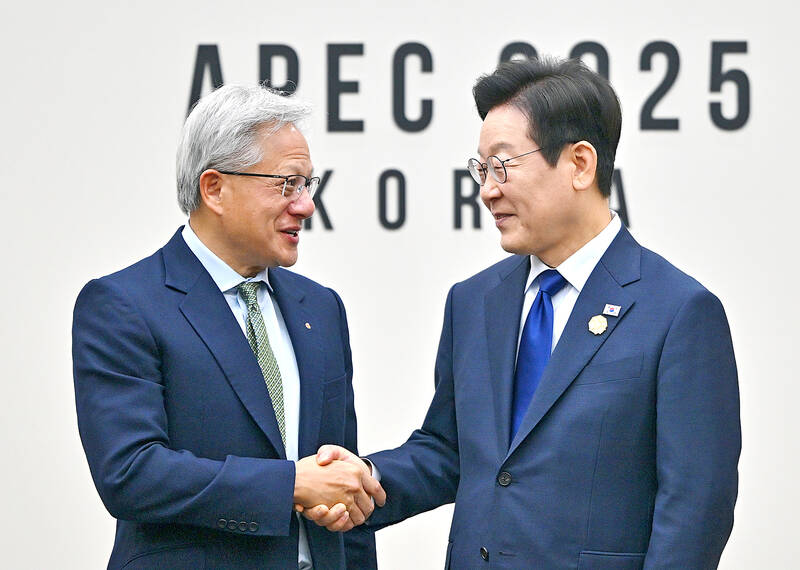Nvidia Corp has forged a landmark deal to supply technology to South Korea’s biggest companies, part of an aggressive push to expand artificial intelligence (AI) infrastructure around the world.
Under agreements brokered with the country’s Ministry of Science and a trio of corporations — Samsung Electronics Co, Hyundai Motor Group and SK Group — Nvidia is to supply more than 260,000 of its accelerator chips to help jump-start South Korean AI projects. The US company did not disclose the financial terms of the deals.
Nvidia CEO Jensen Huang (黃仁勳) was in South Korea attending the APEC CEO Summit yesterday. He used the trip to continue a globe-trotting push to spread the use of AI computing — and fuel demand for his products. The deals in South Korea help further entrench Nvidia’s equipment in a country with a vibrant technology industry.

Photo: AP
As part of the agreements, the South Korean government is building what is known as sovereign AI — computing infrastructure that it controls. It is using more than 50,000 of Nvidia’s latest AI accelerators in data centers in locations such as the National AI Computing Center and facilities owned by companies such as Kakao Corp, Naver Corp and NHN Cloud Corp.
Samsung Electronics, a key supplier of memory chips and one of the world’s largest semiconductor makers, is building an “AI factory” using more than 50,000 Nvidia chips.
Hyundai Motor has committed to using a similar number of processors based on Nvidia’s Blackwell design. The chips are to be used to develop AI models and help advance manufacturing and autonomous driving.
SK Group, which includes affiliates SK Telecom Co and SK Hynix Inc, is deploying an array of Nvidia RTX Pro 6000 Blackwell server chips in what Nvidia called Asia’s first “industrial AI cloud.” The facility is built to assist with robotics and other uses of AI in the physical world.
The AI frenzy has sent Nvidia’s sales — and market capitalization — soaring over the past two years. Earlier this week, it became the first company to reach a valuation of more than US$5 trillion. That followed a company conference in Washington where Huang pointed to strong demand for his products over the coming months.
A lingering question is whether Nvidia would be able to sell its Blackwell processors to China, the world’s largest market for chips. The US has curbed exports of the technology to the Asian nation.
Huang said Nvidia still hopes to sell chips from the company’s Blackwell line to customers in China, though he has no current plans to do so, he told reporters yesterday.
Asked whether Nvidia intends to sell AI accelerators from that family of products, the tech chief said, “I don’t know. I hope so someday.”
He added that chip sales were not discussed during his meeting with Ren Hongbin (任鴻斌), chairman of the China Council for the Promotion of International Trade.
Blackwell is Nvidia’s latest generation of artificial intelligence semiconductors, figuring prominently as a potential bargaining chip in trade talks between the US and China. Licensing the sale of those products did not figure in the discussion between US President Donald Trump and his Chinese counterpart Xi Jinping (習近平) this week, with Trump saying Nvidia and the Chinese government would have to keep talking about the US$5 trillion company’s access to the Asian nation’s market.

US sports leagues rushed to get in on the multi-billion US dollar bonanza of legalized betting, but the arrest of an National Basketball Association (NBA) coach and player in two sprawling US federal investigations show the potential cost of partnering with the gambling industry. Portland Trail Blazers coach Chauncey Billups, a former Detroit Pistons star and an NBA Hall of Famer, was arrested for his alleged role in rigged illegal poker games that prosecutors say were tied to Mafia crime families. Miami Heat guard Terry Rozier was charged with manipulating his play for the benefit of bettors and former NBA player and

The DBS Foundation yesterday announced the launch of two flagship programs, “Silver Motion” and “Happier Caregiver, Healthier Seniors,” in partnership with CCILU Ltd, Hondao Senior Citizens’ Welfare Foundation and the Garden of Hope Foundation to help Taiwan face the challenges of a rapidly aging population. The foundation said it would invest S$4.91 million (US$3.8 million) over three years to foster inclusion and resilience in an aging society. “Aging may bring challenges, but it also brings opportunities. With many Asian markets rapidly becoming super-aged, the DBS Foundation is working with a regional ecosystem of like-minded partners across the private, public and people sectors

BREAKTHROUGH TECH: Powertech expects its fan-out PLP system to become mainstream, saying it can offer three-times greater production throughput Chip packaging service provider Powertech Technology Inc (力成科技) plans to more than double its capital expenditures next year to more than NT$40 billion (US$1.31 billion) as demand for its new panel-level packaging (PLP) technology, primarily used in chips for artificial intelligence (AI) applications, has greatly exceeded what it can supply. A significant portion of the budget, about US$1 billion, would be earmarked for fan-out PLP technology, Powertech told investors yesterday. Its heavy investment in fan-out PLP technology over the past 10 years is expected to bear fruit in 2027 after the technology enters volume production, it said, adding that the tech would

YEAR-END BOOST: The holiday shopping season in the US and Europe, combined with rising demand for AI applications, is expected to drive exports to a new high, the NDC said Taiwan’s business climate monitor improved last month, transitioning from steady growth for the first time in five months, as robust global demand for artificial intelligence (AI) products and new iPhone shipments boosted exports and corporate sales, the National Development Council (NDC) said yesterday. The council uses a five-color system to measure the nation’s economic state, with “green” indicating steady growth, “red” suggesting a boom and “blue” reflecting a recession. “Yellow-red” and “yellow-blue” suggest a transition to a stronger or weaker condition. The total score of the monitor’s composite index rose to 35 points from a revised 31 in August, ending a four-month